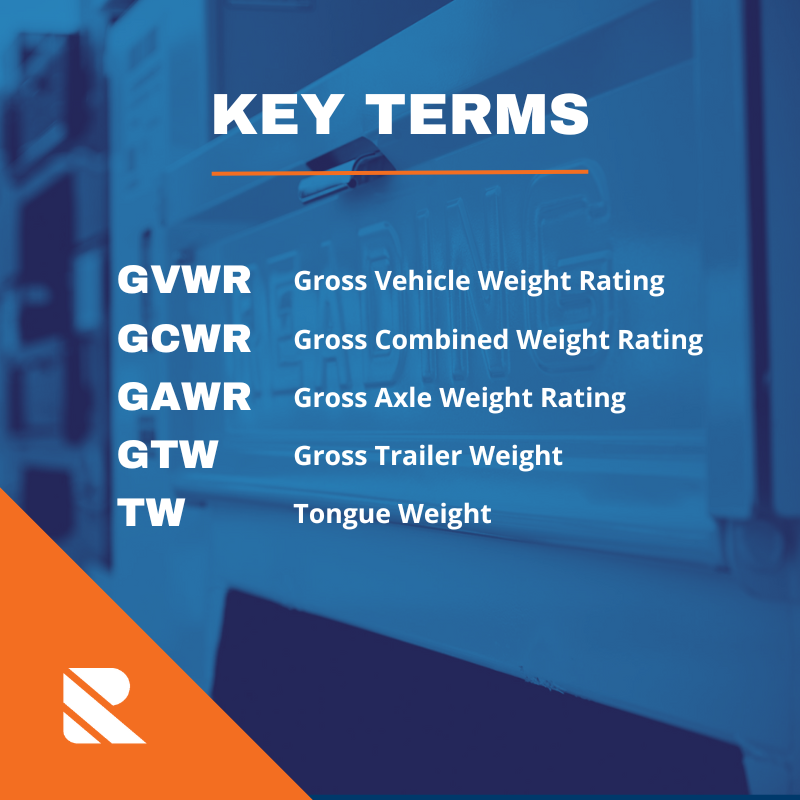Whether towing or hauling cargo, you need to know the capacity your vehicle can handle. Exceeding this value can cause excessive wear on your truck’s engine, transmission, tires, brakes and other components. Learn about towing capacity, payload and other calculations you will need to make to get the most from your truck.
What’s the difference between payload and towing capacity?
A truck’s payload capacity refers to the maximum amount of weight you can safely add to a truck’s cargo area in addition to its curb weight (or empty weight). Towing capacity, on the other hand, refers to the maximum weight that a truck can tow after factoring in the weight of the truck and any cargo.
Many terms are used in the industry — GVWR (gross vehicle weight rating), CW (curb weight), GCWR also known as GCVWR (gross combined vehicle weight rating) and many others. It is important to comprehend these and other related terms to ensure a clear definition for each.


What does GVWR mean?
The GVWR is the maximum safe loaded weight of your vehicle (or trailer), as determined by the manufacturer. GVWR isn’t just the weight of passengers and payload but also the vehicle. You can find your vehicle GVWR on the placard attached to the driver’s door pillar or consult your owner’s manual.
Trucks are classified by the U.S. Federal Highway Administration (FHWA) into classes based on GVWR, ranging from 1 – 8. Classes 1 & 2 are light duty; Classes 3 – 6 are medium duty; and Classes 7 & 8 are heavy duty.
| FHWA Class | Duty Classification | Gross Vehicle Weight Rating (GVWR) |
| Class 1 | Light Duty | Up to 6000 lbs. |
| Class 2a | Light Duty | 6001 to 8500 lbs. |
| Class 2b | Light Duty | 8501 to 10000 lbs. |
| Class 3 | Medium Duty | 10001 to 14000 lbs. |
| Class 4 | Medium Duty | 14001 to 16000 lbs. |
| Class 5 | Medium Duty | 16001 to 19500 lbs. |
| Class 6 | Medium Duty | 19501 to 26000 lbs. |
| Class 7 | Heavy Duty | 26001 to 33000 lbs. |
| Class 8 | Heavy Duty | 33001 to 80000 lbs. |
What is curb weight?
Your vehicle’s curb weight is the complete weight of the vehicle without any people or payload. The curb weight includes all the attached equipment of the vehicle and the weight of necessary operating fluids, such as fuel, oil, and brake fluid.
What is GCWR?
Do not confuse GCWR with GVWR. The former stands for gross combined vehicle weight rating while the latter represents the gross vehicle weight rating. GCWR is the maximum weight of your vehicle with a trailer attached, as determined by the vehicle manufacturer. Combined weight means the weight of both the tow vehicle and the trailer together. It also includes any cargo or load placed in either vehicle. The rating for gross combined vehicle weight is determined by the manufacturer, based on the strength of its frame, suspension, axles, brakes and other towing-related components.
What is trailer tongue weight?
Tongue weight (TW) is the downward force applied at a vehicle-trailer connection point when your trailer is connected for towing. The tongue weight should be between 10-15% of the total trailer weight. Measuring the tongue weight is essential to be certain that your trailer is loaded properly to ensure proper vehicle handling and steering. To measure tongue weight accurately, you can use a specialized tongue weight scale.
How to calculate payload capacity?
To calculate the payload capacity, you need to know both the curb weight and the GVWR. Subtract the curb weight from the GVWR to find the payload capacity.
For example, if you have a light-duty truck with a GVWR of 9,000 pounds and a curb weight of 6,000 pounds, the payload capacity will be 3,000 pounds:
GVWR – curb weight = payload capacity
9,000 pounds – 6,000 pounds = 3,000 pounds
This means that you can put an additional 3,000 pounds into your vehicle that may include people and cargo without any towing added.
If you had a trailer, you also need to subtract the tongue weight from the GVWR. For this same example, if you had a trailer that weighs 2,000 pounds, the tongue weight would be at least 200 pounds. The total payload capacity will now drop to 2,800 pounds:
GVWR – curb weight – tongue weight = payload capacity when towing
9,000 pounds – 6,000 pounds – 200 pounds = 2,800 pounds
For instance, if you were to install a Reading SL service body on a single wheel, 98-inch bed and request steel lids, you will add 1,190 pounds to your truck. Installing this onto a 9,000-pound vehicle with a curb weight of 6,000 pounds will decrease your payload capacity to 1,810 pounds:
GVWR – curb weight – truck body additions = payload capacity with truck add-ons
9,000 pounds – 6,000 pounds – 1,190 pounds = 1,810 pounds payload capacity
How to calculate truck towing capacity?
To determine maximum towing capacity, you will need to know the vehicle manufacturer’s weight ratings and compare them against the gross weight of your trailer. Most vehicles have the trailer towing capacity listed in the owner’s manual, on the driver-side door jamb or in a trailer towing capacity guide on their website.
Why are these numbers important?
Understanding and adhering to your vehicle’s maximum payload and towing capacity is not just a matter of convenience, but it is crucial for safety. Exceeding these limits can lead to problems such as reduced vehicle control, increased stopping distances, mechanical failures, or even serious accidents. By staying within these boundaries, you ensure not only the safety of yourself and your passengers but also of those sharing the road with you. So, before you hitch that trailer or load up your truck, take a moment to calculate your payload and towing capacity and ensure that the tongue weight of the loaded trailer falls within 10 to 15% of the loaded trailer weight. Your safety and the safety of others depend on it.





